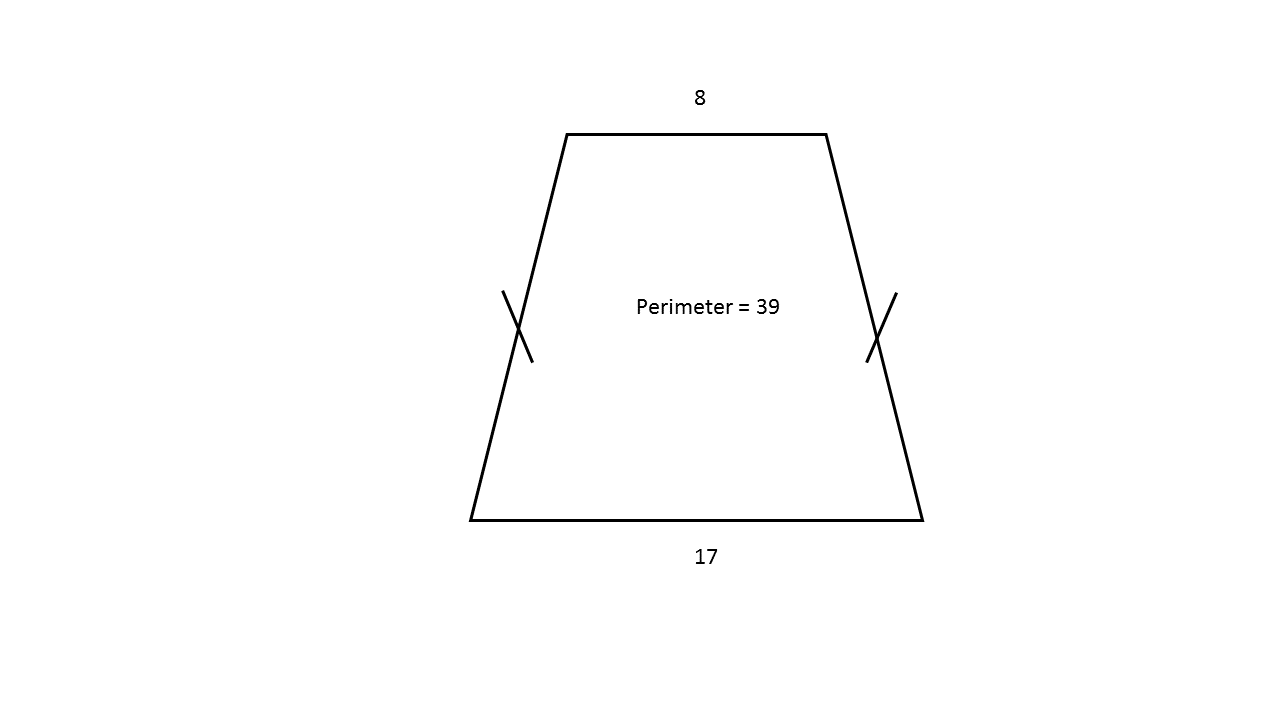

To do this, draw the height of our trapezoid that goes from the vertex between b b b and d d d. However, we don't know c c c, so we'll have to find it still. That means that side c c c is perpendicular to the bases, and therefore equal to the height c = h c = h c = h.
#Area of an isosceles trapezoid using legs and altitude how to#
If the tool can do it, so can we! Let's see how to calculate the area and perimeter of a trapezoid by hand.įirst of all, observe that we're dealing with a right trapezoid since α = 90 ° \alpha=90\degree α = 90° (in fact, we also have β = 90 ° \beta = 90\degree β = 90°). Also, note that we can additionally go into the advanced mode and see the length of the median. For instance, as a trapezoid angle calculator, it will use the identities mentioned in the second section to compute β \beta β and γ \gamma γ. Indeed, if we input the above numbers into our tool (note how we can switch to other units by clicking on them and choosing the suitable one from the list), it will fill out all other fields. Firstly, however, let's observe that our trapezoid calculator can easily handle our problem even with so little information. It doesn't look like much, but let's see what we can do here.

To be precise, looking at the trapezoid angles in our calculator (i.e., at the notation in the picture), we can use the definition of trigonometric functions to write: If you know a little about trigonometry, you'll be able to find the height using the inside angle of the trapezoid. However, there is also one other way to calculate it. If we have the length of a trapezoid's leg and can figure out the other side of the right triangle (i.e., e e e or f f f in the picture above), then we know how to find the height of a trapezoid – we use the Pythagorean theorem. Note that by the way we drew the line, it forms a right triangle with one of the legs c c c or d d d (depending on which top vertex we chose). Nevertheless, what we describe further down still holds for such quadrangles.) The length of this line is equal to the height of our trapezoid, so exactly what we seek. (Observe how for obtuse trapezoids like the one in the right picture above the height h h h falls outside of the shape, i.e., on the line containing a a a rather than a a a itself. Let's draw a line from one of the top vertices that falls on the bottom base a a a at an angle of 90 ° 90\degree 90°. But what if they don't? The bases are reasonably straightforward, but what about h h h? Well, it's time to see how to find the height of a trapezoid. It is always parallel to the bases, and with notation as in the figure, we have m e d i a n = ( a + b ) / 2 \mathrm \times h A = median × h to find A A A.Īlright, we've learned how to calculate the area of a trapezoid, and it all seems simple if they give us all the data on a plate. In other words, with the above picture in mind, it's the line cutting the trapezoid horizontally in half. The median of a trapezoid is the line connecting the midpoints of the legs. In fact, this value is crucial when we discuss how to calculate the area of a trapezoid and therefore gets its own dedicated section.


The height of a trapezoid is the distance between the bases, i.e., the length of a line connecting the two, which is perpendicular to both. Quite a fancy definition compared to the usual one, but it sure makes us sound sophisticated, don't you think?īefore we move on to the next section, let us mention two more line segments that all trapezoids have. Indeed, if someone didn't know what a rectangle is, we could just say that it's an isosceles trapezoid which is also a right trapezoid. With these special cases in mind, a keen eye might observe that rectangles satisfy conditions 2 and 3. Secondly, observe that if a leg is perpendicular to one of the bases, then it is automatically perpendicular to the other as well since the two are parallel. Firstly, note how we require here only one of the legs to satisfy this condition – the other may or may not. We've already mentioned that one at the beginning of this section – it is a trapezoid that has two pairs of opposite sides parallel to one another.Ī trapezoid whose legs have the same length (similarly to how we define isosceles triangles).Ī trapezoid whose one leg is perpendicular to the bases. We'd like to mention a few special cases of trapezoids here. The two other non-parallel sides are called legs (similarly to the two sides of a right triangle). Usually, we draw trapezoids the way we did above, which might suggest why we often differentiate between the two by saying bottom and top base. The two sides, which are parallel, are usually called bases.


 0 kommentar(er)
0 kommentar(er)
